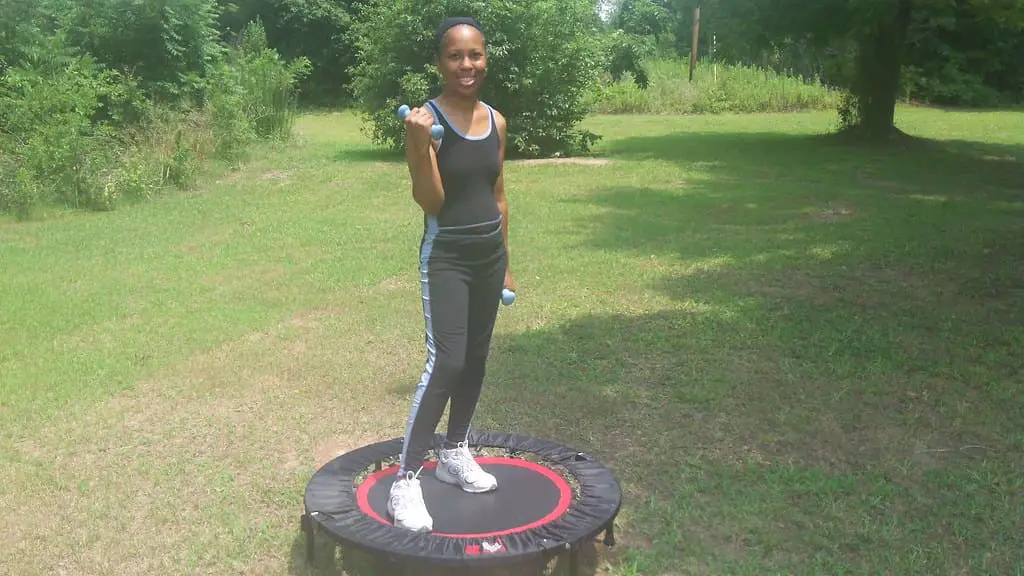Jumping on a trampoline can be fun and good for our bodies, but can you jump on trampoline when pregnant? Many people think it’s unsafe, but that’s not entirely true.
The short answer is yes, you can jump on a trampoline while pregnant, but it’s not for everyone. Even if you were active and fit before getting pregnant, you should still talk to your doctor first. Every woman’s pregnancy is different; your doctor can give you personalized advice.
You should know a few things if you want to jump on a trampoline during your pregnancy. First, make sure to talk to your doctor before trying it. They will tell you if it’s safe for you and your baby.
Also, be aware that pregnancy changes your body, so what was safe before might not be safe now. Take it easy and listen to your body. If something doesn’t feel right, stop and rest. It’s always better to be cautious and ensure you and your baby stay safe.
Can you jump on trampoline when Pregnant: Jumping on a trampoline while pregnant can be safe, but it’s important to consult your doctor first. They can provide personalized advice based on your individual pregnancy and health factors.
Can you jump on trampoline when Pregnant?

Jumping on a trampoline while pregnant should be avoided unless your doctor says it’s okay. If your doctor gives you the green light, take precautions to prevent injuries.
Use safety measures like a net and pad to protect yourself from falls and hard surfaces. It’s best to jump alone but have someone nearby if you need assistance. Even with safety measures, there’s still a risk of falling, so see your doctor if you do.
Overall, doing light and low bounces on a trampoline while pregnant is safe. Pregnancy changes your body, so exercise can help with weight management, joint flexibility, and pain reduction.
What are the reasons why jumping on a trampoline is not recommended during pregnancy?
Jumping on a trampoline while pregnant is not recommended because it can cause excessive movement of the fetus and increase the risk of falling.
The uterine’s amniotic fluid helps protect the baby, but the changes in your body’s center of gravity during trampolining can disrupt this protection.
In rare cases, it may lead to placental detachment and, in severe cases, the loss of the baby. To ensure your and your baby’s safety, it’s best to avoid jumping on a trampoline during pregnancy.
Is it Safe to Jump on a Trampoline During the First Trimester of Pregnancy?
Jumping on a trampoline during pregnancy’s first trimester may be unsafe. In the first trimester, your body might not show many changes, but the baby’s growth is crucial during this time.
There is a higher risk of birth abnormalities during the first trimester, and falling from a trampoline can harm you and the baby. Additionally, weight gain during pregnancy can shift your center of gravity, making it more likely to lose balance and fall.
It’s best to avoid activities like jumping, bouncing, or sudden changes in direction to prevent the risk of falling or injuring yourself. It’s important to prioritize your safety and your baby’s well-being during this critical pregnancy stage.
Trampoline Jumping During Early Pregnancy: Is it Safe?

As your pregnancy progresses, your body will change, and you’ll gain weight, affecting your balance and center of gravity.
Trampolining involves bouncing and can make it easier to lose balance and fall.
Many women wonder if these movements will harm their growing baby, but the baby is protected and may even enjoy the rocking sensation. However, despite this, jumping on a trampoline is still not recommended during pregnancy.
Safety of Jumping on a Trampoline During Early Pregnancy:
Exercise is beneficial during pregnancy as it helps with weight management and can make labor easier. Trampolining is an effective form of exercise that can help prevent excessive weight gain starting from early pregnancy.
So, in general, it is possible to jump on a trampoline during early pregnancy. However, it is important to consult with your doctor before doing so to ensure it is safe for you and your baby.
Jumping on a Trampoline During the Second Trimester of Pregnancy
Your doctor will guide suitable physical activities during the second trimester of pregnancy. If jumping on a trampoline doesn’t cause any discomfort, you can continue doing it, but be cautious.
Keep in mind that your body weight will have increased compared to the first trimester, and jumping may affect your balance.
It’s important to note that some pregnant women are advised to rest and avoid strenuous activities during the second trimester. Always consult with your healthcare provider to ensure you make the best decisions for your health and your baby’s health.
Jumping on a Trampoline During the Third Trimester of Pregnancy
It’s best to avoid heavy physical activities during the third month of pregnancy. Your body is at its maximum weight, and your balance is different from before. This can increase the risk of losing balance and potentially harming the baby.
Additionally, avoiding jumping on a trampoline in the weeks following childbirth is important. Doing so too soon can lead to complications like premature labor and placental abruption.
It’s crucial for expectant mothers, especially those in their first pregnancy, to consider these risks before engaging in trampolining. Instead, focus on preparing for the arrival of your new baby during the last trimester of pregnancy.
Rocking and Bouncing Movements with the Baby During Pregnancy
Some women wonder if the movements caused by jumping on a trampoline will bother the baby or create too much rocking and bouncing in the womb. The simple answer is no; the baby is safe and comfortable with the rocking and bouncing of your body.
Some babies are even comforted by the rhythm. However, despite this, it’s still not recommended to jump on a trampoline while pregnant.
Safe Trampoline Exercises for Pregnant Women
If your doctor permits you to jump on a trampoline during pregnancy, here are some simple exercises you can try. However, if you didn’t have experience with trampolining before getting pregnant, it’s best to choose other pregnancy-friendly workouts.
Keep in mind that high-intensity exercises should be avoided until after delivery. Here are a few trampoline exercises you can do: basic bouncing, trampoline prances, and trampoline squats.
Remember to always prioritize your safety and consult with your healthcare provider before starting any new exercise routine during pregnancy.
Potential Risks of Trampolining During Pregnancy
Jumping on a trampoline while pregnant carries several risks. Incorrect use of trampolines during pregnancy can lead to premature birth, low birth weight, and birth defects. The risk of falling is also significantly increased, posing a danger to both the mother and the baby.
Other risks include experiencing severe nausea and vomiting after jumping, potential injuries to the baby when landing on the mat or ropes, and in rare cases, spinal cord injuries from falling from a high height.
If you decide to use a trampoline while pregnant, it is crucial to consult with your doctor first. They can provide personalized recommendations based on your specific situation. Before using the trampoline, carefully inspect it for any damage or tears.
It’s important to only jump on the trampoline with proper safety gear, such as a safety net and safety pads. If you experience any discomfort during jumping, it’s essential to stop immediately and seek medical attention.
Safe and Simple Trampoline Exercises for Pregnant Women
Begin by focusing on maintaining your balance during basic warm-up exercises. You can start with a slow jog on the trampoline, going as far as you feel comfortable.
Next, try performing slow and controlled jumping jacks. Repeat this cycle as many times as you can, making sure to leap with proper balance and control.
Here are some additional recommendations for pregnant women using trampolines.
Step-by-Step Movements on the Trampoline:
Pregnant women can easily perform this simple workout, which helps reduce joint and knee discomfort while improving balance and coordination.
Jumping for Pregnant Women:

When using a mini-trampoline or rebounder, make sure your feet are 15 cm apart.
Keep your hands on your hips and slightly bend your knees. Use your heels to bounce on the trampoline.
Alternate raising one leg at a time, bringing your knees up to hip level. Switch your legs and knees as you continue the exercises for at least five minutes.
Gentle Bouncing on the Trampoline:
Low-key bouncing is considered one of the best exercises for pregnant women. When bouncing, try to bend your knees as it has benefits for your immune system. It helps improve lymphatic circulation, which contributes to overall good health.
Stationary Running on the Trampoline:
Soft jogging is a safe and beneficial exercise for pregnant women. By running in this gentle manner, you can improve your balance. It’s important to remember that your center of gravity changes during low-height running, so it’s crucial to maintain your balance at all times.
Pike Jumps for Pregnant Women:
Perform a graceful jump from a standing position, extending your legs straight in front of you. Try to reach your feet with your extended arms. Repeat these instructions for one to three minutes.
Advantages of Trampoline Use During Pregnancy
Using a trampoline during pregnancy is not necessary, but it can offer some benefits. If you choose to use a trampoline, it’s important to only do light and gentle exercises for safety. Here are some of the advantages of using trampolines while pregnant:
- Improved Mood: Many pregnant women experience antenatal depression, which can cause prolonged sadness. Jumping on a trampoline can help uplift their mood by releasing endorphins, the “feel-good” hormones.
- Fitness and Weight Management: Staying fit and healthy during pregnancy is important, and trampoline jumping can help maintain weight and minimize fat gain in a safe and controlled manner.
- Relieving Back and Joint Pain: Pregnancy often leads to additional weight, which can cause discomfort, especially in the back and joints. Using a suitable trampoline can provide relief from such pain and discomfort.
- Managing Gestational Hypertension: Some pregnant women may experience gestational hypertension but are unable to take medication. Jumping on a trampoline can be an effective way to help manage this condition and reduce its impact.
Remember to consult with your healthcare provider before using a trampoline during pregnancy to ensure it is safe for you and your baby.
Using a Trampoline After Giving Birth

After giving birth, it’s beneficial for mothers to engage in trampoline exercises, but it’s important to be patient and allow your body enough time to recover.
Wait at least two months before starting trampoline workouts, as your body is still sensitive, fragile, and fatigued from childbirth.
During this period, focus on simple exercises that promote fitness and health.
Postpartum exercise is highly recommended as it helps strengthen the pelvic floor and facilitates getting back into shape. Following a proper exercise routine allows you to regain strength gradually and improve your overall well-being.
Remember, the key is to listen to your body and not push yourself too hard. If you experience any discomfort or exhaustion, adjust the exercises accordingly. Consult with your healthcare provider or a postpartum fitness specialist for personalized guidance.
By taking the time to recover and gradually incorporating trampoline exercises into your routine, you can regain strength, improve fitness, and enjoy the many benefits of postpartum exercise.
Trampoline Safety Considerations
Here we discuss some Trampoline Safety Considerations for women’s pregnancy:
Potential risks of trampoline use during pregnancy
When considering trampoline use during pregnancy, it’s important to be aware of the potential risks involved. Jumping on a trampoline can pose certain challenges and hazards for pregnant women due to the physical changes that occur during pregnancy.
These risks include:
- Impact on joints, ligaments, and pelvic floor: Pregnancy hormones can loosen ligaments, making them more susceptible to injury. Jumping on a trampoline puts added stress on joints and ligaments, which may lead to strains or sprains. It can also put pressure on the pelvic floor muscles, potentially contributing to pelvic floor dysfunction.
- Increased risk of falls and injuries: As pregnancy progresses, the body’s center of gravity shifts, and balance can be compromised. This increases the risk of falls and injuries while jumping on a trampoline. A fall during pregnancy can have serious consequences for both the mother and the baby.
Safety Measures to Reduce Risks
If you decide to engage in trampoline exercise during pregnancy, it’s crucial to prioritize safety and take necessary precautions to minimize the associated risks.
Here are some safety measures to consider:
- Consult with your healthcare provider: Before starting any trampoline exercise routine, consult with your healthcare provider to ensure it is safe for you and your baby. They can provide personalized advice based on your health and pregnancy.
- Choose pregnancy-friendly exercises: Opt for low-impact exercises that are gentle on your body, such as walking, swimming, or prenatal yoga. These activities provide similar benefits to trampoline exercise without the associated risks.
- Use proper technique: If you have prior trampolining experience and receive clearance from your healthcare provider, focus on maintaining proper technique. This includes keeping your knees slightly bent, using controlled movements, and avoiding high-impact jumps.
- Ensure a safe trampoline environment: If using a trampoline, ensure it is in good condition, properly assembled, and equipped with safety features such as a safety net and padded frame. Regularly inspect the trampoline for any damage or wear.
- Exercise with a spotter: Have someone nearby to provide support and assistance, especially if you experience any discomfort or need help maintaining balance.
- Listen to your body: Pay attention to your body’s signals and limitations. If you feel any pain, dizziness, or discomfort while exercising on the trampoline, stop immediately and consult your healthcare provider.
- Stay hydrated and take breaks: Drink plenty of water to stay hydrated and take regular breaks to rest and prevent overheating.
Remember, the priority during pregnancy is your and your baby’s health and safety. It’s essential to make informed decisions, seek professional guidance, and prioritize safe and suitable activities for your specific circumstances.
Professional Medical Advice

Here are some professional medical advice:
Importance of consulting with a healthcare provider:
It is crucial to consult with your healthcare provider before engaging in any exercise, including trampoline use, during pregnancy. They know your specific health needs and can provide personalized advice based on your medical history and current pregnancy condition.
Discussing personal health history and pregnancy condition:
When consulting with your healthcare provider, discuss your health history, including any previous pregnancies, medical conditions, or complications.
It’s important to provide them with accurate information so they can assess if trampoline use is appropriate for you and address any potential risks or concerns.
Seeking guidance from a prenatal fitness expert or physical therapist:
In addition to consulting with your healthcare provider, you may seek guidance from a prenatal fitness expert or a physical therapist specializing in working with pregnant individuals.
They can provide specialized knowledge and guidance on safe and effective exercises during pregnancy, including modifications for trampoline use. They can help tailor an exercise plan that suits your specific needs and ensures your and your baby’s safety.
Remember, every pregnancy is unique, and what may be suitable for one person may not be suitable for another.
Following professional medical advice and seeking guidance from qualified experts will help you make informed decisions about exercise during pregnancy and prioritize the health and well-being of both you and your baby.
Alternative Exercise Options
During pregnancy, it’s important to prioritize safe, comfortable, and suitable exercise for your changing body. If trampoline use is not recommended or if you prefer other forms of exercise, there are various alternative options to consider:
Walking:
Walking is a low-impact exercise that can easily be incorporated into your daily routine. It helps improve cardiovascular fitness, strengthen leg muscles, and maintain overall health. Aim for at least 30 minutes of brisk walking most days of the week.
Prenatal Yoga or Pilates:
These forms of exercise focus on gentle stretching, strengthening, and relaxation techniques specifically designed for pregnant women. They can help improve flexibility, posture, and muscle tone while promoting relaxation and reducing stress.
Swimming or Water Aerobics:

Exercising in water provides buoyancy and supports your growing belly, relieving pressure on joints and reducing the risk of injury. Swimming and water aerobics are excellent low-impact options that offer cardiovascular benefits and help alleviate swelling and discomfort.
Stationary Cycling or Using an Elliptical Machine:
These machines provide a controlled, low-impact workout that helps improve cardiovascular fitness without putting excessive stress on your joints. Adjust the intensity and resistance levels to suit your comfort and fitness level.
Prenatal Fitness Classes:
Consider joining specialized prenatal fitness classes catering to pregnant women’s needs. These classes may include gentle aerobics, strength training, and flexibility exercises that are tailored to accommodate the changes in your body during pregnancy.
Listen to your body, stay hydrated, and avoid exercises that cause discomfort, pain, or excessive fatigue. Always consult with your healthcare provider before starting any new exercise routine, especially during pregnancy, to ensure it is safe for you and your baby.
Trampoline Use in Moderation
While trampolining can be a fun and effective form of exercise, it’s important to use trampolines in moderation, especially during pregnancy. Here are some considerations to keep in mind:
Consult With Your Healthcare Provider:
Before engaging in trampoline activities, consult with your healthcare provider. They can assess your situation, consider any potential risks or complications, and provide personalized guidance on whether trampolining is safe for you during pregnancy.
Practice Caution and Moderation:
Remember to exercise caution and moderation if your healthcare provider gives you the go-ahead to use a trampoline. Avoid performing high-impact or vigorous exercises on the trampoline. Stick to low-impact movements and gentle bouncing to minimize the risk of falls or injuries.
Focus on Stability and Balance:
As your body changes during pregnancy, your center of gravity shifts, and your joints and ligaments become more flexible. Pay close attention to your balance and stability while on the trampoline.
Keep your movements controlled and maintain proper body alignment to reduce the risk of strain or injury to your joints, ligaments, and pelvic floor.
Use Safety Measures:
Ensure that your trampoline has safety features such as a safety net and padded frame. Regularly inspect the trampoline for any damage or wear and tear. It’s also important to have someone present while using the trampoline, especially during the later stages of pregnancy, to assist if needed.
Listen to Your Body:
Throughout your trampoline sessions, listen to your body’s cues. If you experience any discomfort, pain, dizziness, or excessive fatigue, stop exercising and rest. Pay attention to any changes in your body and adjust the intensity or duration of your trampoline workouts accordingly.
Remember, every pregnancy is unique, and what may be safe for one person may not be suitable for another.
It’s always best to prioritize your health and safety, and if in doubt, seek guidance from your healthcare provider or a prenatal fitness expert to ensure you are engaging in exercises that are appropriate for your specific needs and stage of pregnancy.
Precautions and Safety Measures
When using a trampoline, especially during pregnancy, it’s important to take precautions and follow safety measures to minimize risks and ensure a safe exercise experience. Here are some key precautions and safety measures to keep in mind:
Using trampolines with safety enclosures and pads:

Opt for trampolines that come with safety enclosures and pads. These features provide additional protection and minimize the risk of falls and injuries.
Avoiding high-impact jumps, flips, and vigorous bouncing:
During pregnancy, avoiding high-impact jumps, flips, and vigorous bouncing is advisable. Opt for low-impact exercises that are gentle on your joints and pelvic floor.
Wearing supportive footwear and comfortable clothing:
Choose supportive footwear that provides stability and helps maintain your balance on the trampoline. Additionally, wear comfortable clothing that allows for unrestricted movement.
Trampoline exercises suitable for pregnant women:
Engage in trampoline exercises suitable for pregnant women, such as low-key bouncing, gentle jogging, controlled jumping jacks, and pike jumps. These exercises help improve balance, coordination, and overall fitness while minimizing risks.
Remember to listen to your body and modify or stop any exercise that causes discomfort, pain, or excessive fatigue.
Always follow the guidance of your healthcare provider and seek advice from a prenatal fitness expert or physical therapist to ensure that the trampoline exercises you choose are appropriate for your specific pregnancy condition.
By following these precautions and safety measures, you can enjoy the benefits of trampoline exercises while minimizing potential risks during pregnancy.
Signs to Stop Trampoline Use
While trampoline exercises can be beneficial during pregnancy, it’s important to be aware of the signs that indicate you should stop using the trampoline. Here are some signs to watch out for:
Warning Signs From Your Body:
Listen to your body and be aware of any unusual sensations or discomfort. If you experience dizziness, shortness of breath, chest pain, severe fatigue, or any other concerning symptoms, it’s important to stop immediately.
Indications of Overexertion or Discomfort:
If you feel excessively tired, lightheaded, or experience pain in your joints, back, or pelvic region during or after trampoline use, it’s a sign that you may be overexerting yourself. Discomfort or pain in your abdomen should also be taken seriously.
Knowing When to Stop and Seek Medical Advice:
If any of the above signs or any other unusual symptoms occur, it’s important to stop using the trampoline and consult with your healthcare provider. They can evaluate your condition, provide guidance, and determine if further medical attention is needed.
Remember, your health and the well-being of your baby are top priorities. It’s always better to err on the side of caution and seek professional advice if you have any concerns about trampoline use during pregnancy.
Are Trampolines Safe While Pregnant?
While trampolines can be a fun activity, there are certain risks associated with using them during pregnancy. It’s always best to consult with your healthcare provider before engaging in any new physical activity while pregnant, including trampoline use.
Here are a few factors to consider:
Risk of Falls:
During pregnancy, the body undergoes changes that can affect balance, including shifts in the center of gravity and the increasing weight of the baby. Jumping on a trampoline introduces a risk of falls, which can potentially cause injuries to both the pregnant person and the developing fetus.
Due to these concerns, it is generally not recommended to jump on a trampoline while pregnant to prioritize the safety and well-being of both individuals.
It’s important to explore alternative forms of exercise that are considered safer and consult with a healthcare provider for personalized advice based on individual circumstances.
Jarring Movements:
Jumping on a trampoline entails bouncing and sudden movements that can place additional strain on ligaments, joints, and pelvic floor muscles. Throughout pregnancy, these structures are already under heightened stress due to hormonal changes and the weight of the growing baby.
Subjecting them to excessive strain through trampolining may result in discomfort or potential complications. The pelvic floor muscles, in particular, play a vital role in supporting the pelvic organs and maintaining continence, and overexertion could weaken them.
Additionally, the jarring impact of trampoline activities might exacerbate joint discomfort or existing musculoskeletal issues.
Considering these factors, it is generally advised to avoid jumping on a trampoline during pregnancy and instead opt for exercises that are gentler on the body but still promote fitness and well-being.
Consulting with a healthcare provider is essential to receive personalized guidance based on individual circumstances.
Risk of Abdominal Trauma:
There is a risk of hitting the abdomen on the trampoline surface or accidentally colliding with another person while bouncing. Trauma to the abdominal area can be harmful to the baby, potentially causing placental abruption or other complications.
Considering these risks, it’s generally recommended to avoid trampolines during pregnancy. There are many other safe and low-impact exercises suitable for pregnant women, such as walking, swimming, prenatal yoga, and stationary cycling.
These activities can help maintain fitness and promote overall well-being without the potential hazards associated with trampolining.
Always consult with your healthcare provider for personalized advice based on your specific pregnancy and health conditions. They can provide the most accurate guidance on what activities are safe for you and your baby during this special time.
Are you allowed to jump on a Trampoline while Pregnant?
The decision to jump on a trampoline while pregnant is ultimately up to you and your healthcare provider. While some pregnant women may be able to engage in light trampoline activity without any issues, it’s important to consider the potential risks and consult with your healthcare provider before doing so.
If you have a low-risk pregnancy, your healthcare provider may give you the go-ahead for gentle bouncing on a trampoline. They may provide guidelines on how to do it safely, such as avoiding high jumps, abrupt movements, or activities that may increase the risk of falls or abdominal trauma.
It’s crucial to prioritize your safety and the well-being of your baby during pregnancy. Your healthcare provider will consider your specific circumstances, medical history, and any potential complications before advising on trampoline use.
Remember to have open and honest communication with your healthcare provider and follow their guidance regarding physical activities during pregnancy. They will be able to provide you with the most accurate and personalized information based on your situation.
Can Jumping on Trampoline Affect Ability to Get Pregnant?
Jumping on a trampoline does not have a direct impact on a person’s ability to conceive or get pregnant. The act of jumping on a trampoline, in and of itself, does not affect reproductive function or fertility.
However, it’s worth noting that excessive physical activity or intense exercise routines can sometimes disrupt a woman’s menstrual cycle and potentially affect fertility.
If a woman engages in very high-intensity or vigorous exercise regularly, it could lead to hormonal imbalances or irregularities in her menstrual cycle. These imbalances might make it more difficult to predict ovulation accurately, which could affect conception timing.
If you’re actively trying to conceive, it’s generally advisable to maintain a healthy and balanced exercise routine. Moderate-intensity exercises, including trampoline use, are generally considered safe and can contribute to overall well-being.
However, it’s always a good idea to consult with your healthcare provider about your exercise plans, as they can provide personalized guidance based on your specific health history and fertility goals.
If you have concerns about your fertility or difficulties conceiving, it’s recommended to seek medical advice from a reproductive specialist or fertility expert who can evaluate your situation and provide appropriate guidance.
Can you Jump on a Trampoline while 13 Weeks Pregnant?
Engaging in activities such as jumping on a trampoline while 13 weeks pregnant carries potential risks that should be taken into consideration.
At this stage, your body is going through various changes to accommodate the growing baby, and it is crucial to prioritize your safety and the well-being of your unborn child.
During pregnancy, your balance and coordination may be affected due to shifts in your center of gravity. Jumping on a trampoline introduces a risk of falls and loss of balance, which can result in injuries that could harm you or the developing baby.
Additionally, trampolining involves sudden and forceful movements that can strain your joints, ligaments, and pelvic floor muscles.
These areas are already under increased stress due to hormonal changes and the weight of the growing baby, and subjecting them to excessive strain may lead to discomfort or potential complications.
Furthermore, there is a possibility of abdominal trauma when jumping on a trampoline. Accidental collisions falls, or incorrect landings can pose a risk of impacting the abdomen, which could potentially harm the baby.
Considering these factors, healthcare professionals generally advise against jumping on a trampoline during pregnancy. It is important to explore alternative forms of exercise that are considered safe and suitable for your stage of pregnancy.
Always consult with your healthcare provider for personalized guidance based on your specific pregnancy and health conditions.
FAQs:
Q:1 Is it safe to use a trampoline during pregnancy?
You should avoid engaging in vigorous activities that can be too intense or risky during pregnancy. Examples include high-impact aerobics and trampolining, as they can put a strain on your body and increase the risk of injury.
Additionally, it’s important to steer clear of contact sports or any activities that may cause you to lose balance or fall, as they can pose a danger to you and your baby. It’s best to prioritize safe and suitable activities for your pregnancy.
Q:2 When is it recommended to stop jumping on a trampoline while pregnant?
The timing for stopping these exercises during pregnancy will depend on each woman’s situation. Some women may be able to continue these exercises until the second trimester, while others may need to stop earlier, even in the first trimester.
It’s important to listen to your body and consult your healthcare provider to determine the right time to pause or modify these exercises. Every pregnancy is different, so what works for one woman may not work for another.
Q:3 Can jumping on a trampoline pose a risk to early pregnancy?
Exercising during pregnancy is generally safe for your baby. Research suggests that women who stay active during pregnancy are less likely to encounter complications during later stages of pregnancy and childbirth.
It’s important to remember that regular exercise, tailored to your comfort and abilities, can benefit you and your baby. However, it’s always a good idea to consult with your healthcare provider before starting or continuing any exercise regimen during pregnancy to ensure it is appropriate for your situation.
They can provide guidance and make recommendations based on your health and pregnancy.
Q:4 Is it safe for a pregnant woman to jump up?
According to Dr. Iffath Hoskins, an ob-gyn at NYU Langone Health, the answer is yes, as long as you approach it sensibly and cautiously. If you have a healthy pregnancy, jumping rope can be a beneficial form of cardio exercise.
It can help improve balance and flexibility and strengthen your muscles and joints. However, it’s important to listen to your body and not overexert yourself.
If you experience discomfort, pain, or complications during jumping rope, it’s best to stop and consult your healthcare provider. They can provide personalized advice.
Q:5 What sports should be avoided during pregnancy?
Here are some exercises to avoid while pregnant:
- Contact sports: Sports like soccer, volleyball, and basketball involve physical contact with other players, which may pose a risk of injury to you and your baby.
- High-risk activities: Exercises that put you at risk of falling, such as downhill skiing, off-road cycling, and gymnastics, should be avoided to prevent any potential harm to you and your baby.
- Heavy bouncing activities: Activities that involve heavy bouncing, like horseback riding, can put a strain on your body and may not be suitable during pregnancy.
It’s important to prioritize your safety and your baby’s well-being during pregnancy. Always consult your healthcare provider before engaging in any exercise or physical activity to ensure it is safe for you and your pregnancy.
They can provide personalized guidance based on your health condition and pregnancy stage.
Conclusion:
Jumping on a trampoline while pregnant is a topic of concern and debate among healthcare professionals. While some women may be able to safely engage in trampoline activities during pregnancy, it is generally not recommended due to potential risks and safety concerns.
Pregnancy brings about changes in the body, including increased weight, changes in balance, and the presence of relaxin hormone that affects ligament laxity.
Jumping on a trampoline can expose the mother and the developing fetus to various risks. The impact and bouncing motion can strain the joints, ligaments, and pelvic floor muscles, potentially leading to discomfort, injury, or exacerbating existing conditions.
There is also an increased risk of falling or losing balance, which can result in serious injuries to both the mother and the baby.
It is essential to prioritize the safety and well-being of both the mother and the unborn child during pregnancy. It is advisable to consult with a healthcare provider before engaging in any trampoline activities.
They can assess individual circumstances, provide personalized advice, and recommend alternative exercises or activities that are safer and more suitable for pregnant women.
We hope you will be well aware of “Can you jump on trampoline when pregnant?”, after reading this comprehensive article. If you have any questions, feel free to comment below!

